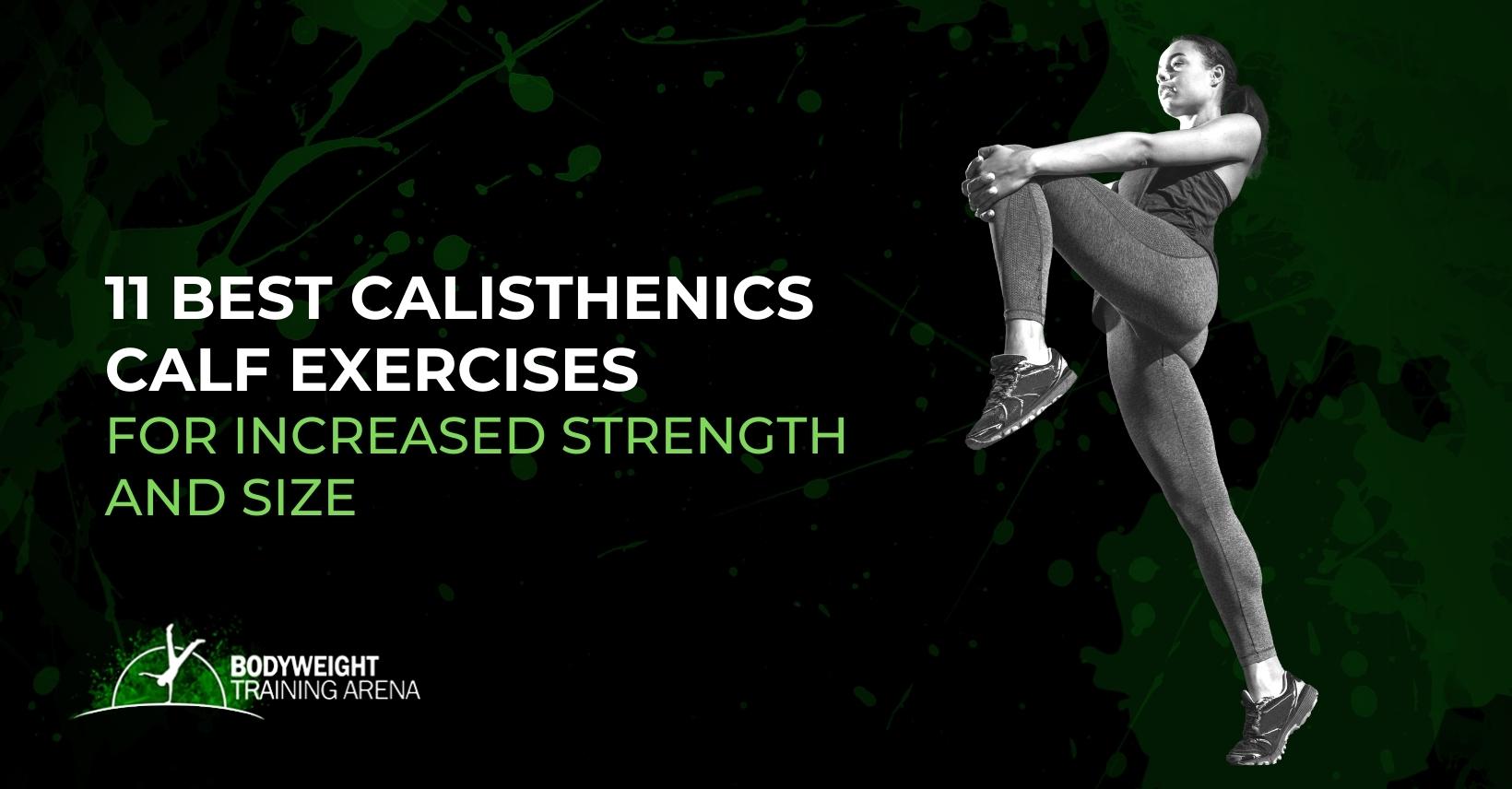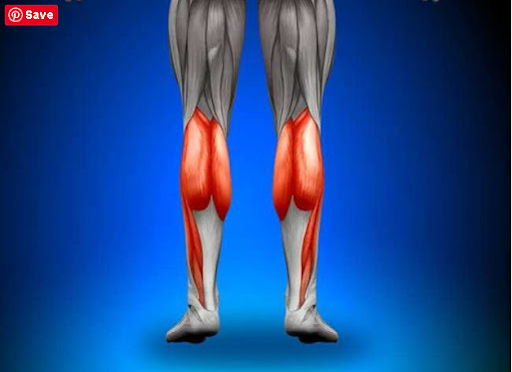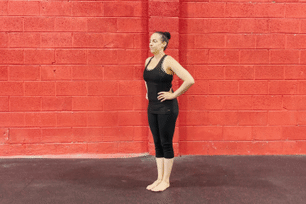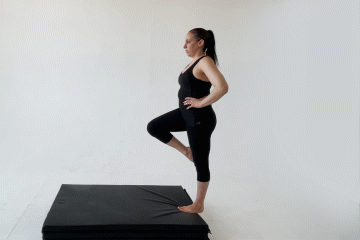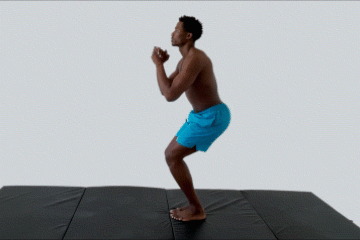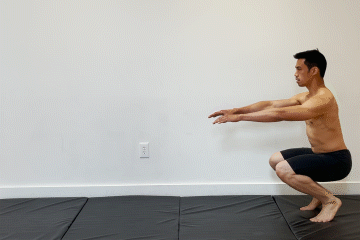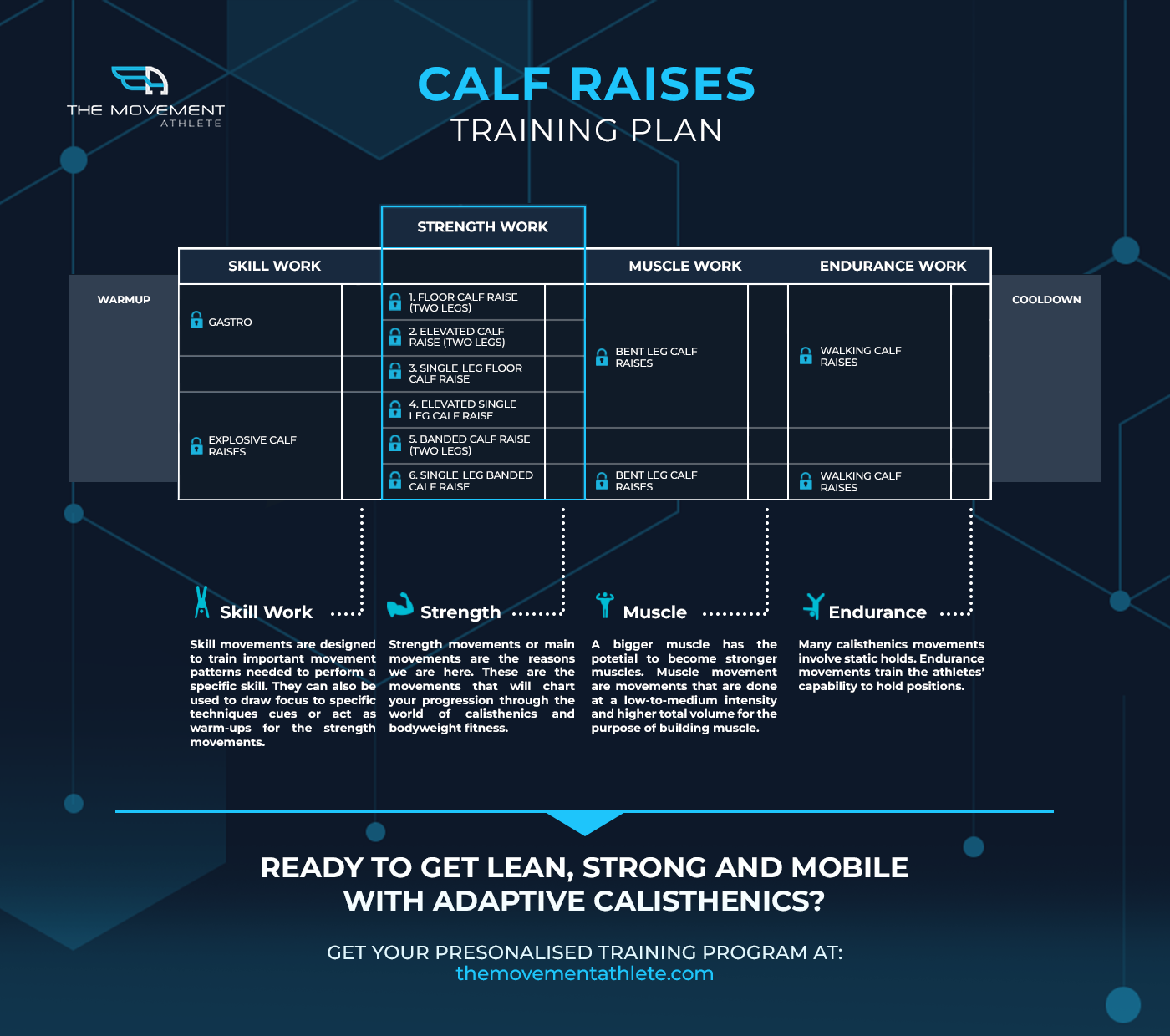Do you want to improve your calf strength and size? If so, you need to be doing the best calisthenics calf exercises. These exercises are a great way to target your calves and help you achieve the results you are looking for.
In this article, we will discuss the best exercises for calves and how to perform them correctly. We will also provide tips on how to progress in these exercises over time.
Here’s a quick summary of what we have for you!
- 🎯 What is the calf
- 🎯 Why is it important to train them
- 🎯 4 amazing tips to build toward bigger calves
- 🎯 The 11 best calisthenics calf exercises
- 🎯 Calf workout sample
- 🎯 Frequently Asked Questions
If you need the complete list of calisthenic legs exercises to complete your lower body workout, then check out this article: 📍101 bodyweight leg exercises list
Let’s get started!
🔎What is the calf?
Calf muscles are a group of muscles located in the lower leg. The primary function of these muscles is to plantarflex the foot, which means to point the toes downward. This action is important in activities such as walking and running.
The calf muscle group is made up of two main muscles:
Gastrocnemius: This is the large, two-headed muscle that makes up the majority of the calf. It is responsible for plantarflexion and also assists in knee flexion. This muscle is the one most giving impact on calf size.
Soleus: This muscle lies underneath the gastrocnemius and is smaller in size. It also aids in plantarflexion and provides stability to the ankle joint. This muscle can be activated well with seated calf raises. Improving this muscle helps improve size.
These muscles work together to produce the actions of plantarflexion, knee flexion, and ankle inversion. When these muscles are strong and well-developed, they can help improve your performance in activities such as running, jumping, and walking and help prevent injuries.
🔎Why do we need to train the calf muscles?
Aside from aesthetic purposes, the calf muscles are crucial for performance and everyday movement patterns. A strong and well-developed calf can:
- 🏆 Improve running speed and jumping ability
- 🏆 Prevent injuries to the ankle, knee, and hip
- 🏆 Improve balance and stability
- 🏆 Better leg control & movement pattern
- 🏆 Improve leg aesthetic with balanced legs
- 🏆 Better quality of life
🤔Is it possible to grow the calves with just your body weight?
One of the 📍most popular myths about calisthenics is that bodyweight training cannot build bigger legs and calves.
This is simply: FALSE.
You can definitely grow your legs and even the most frustrating muscle to grow, the calves, with calisthenics. But it takes some work that should be aligned toward this specific goal.
Read more on building bigger legs here: 📍Turn Your Legs into Tree Trunks!
Here are 4 effective tips you need to keep in mind to grow your stubborn calf muscles.
⭐️4 Tips for Bigger Calves
✊Get enough volume
A 2021 systematic review explains that inducing muscle growth through resistance training comes from getting enough effort into your work. This means that your calf training should be challenging enough.
You can either get a higher intensity exercise with a relatively low rep range and training volume or since we’re using our own body weight, we can use a moderately intense exercise with high training volume.
Bodyweight training can limit our calf training intensity, so we have to adjust other protocols such as training volume.
While a very recent 2022 study shows that training to failure is not necessary for muscle growth, in our case of growing the calves with just our body weight, training failure is a good indicator that we’re getting enough stimulus in our workout. This holds especially true for more intermediate athletes who have already gained muscle and strength.
✊Use proper exercises with good execution
Like when working with any other exercise or goal, you need to get the 📍proper progression that suits your goal and skill level. Along with that is following the correct technique to maximize the efficiency of your training while minimizing the risk of injury.
We don’t just do the proper form because it looks good. We do it because it’s the most effective path towards the exercise goal and the safest way to do it.
✊Slower tempo
Slower movement means longer time under tension. Your calf muscles will be subjected to forceful stimulation for an extended period of time creating muscle damage. This opens the opportunity for muscle growth. Adding pauses at peak contraction is also ideal.
✊Don’t quit!
Many fail to build their calves with calisthenics because they quit too early in their journey. The calf muscles are very stubborn and won’t immediately grow even if you use weights.
Don’t stop training your calf muscles and you will eventually see growth.
More on these amazing calf-building tips here: 📍4 Biggest Secrets to Bigger Calves!
Why do you have skinny calves?😱
You’re not simply doing enough work with good enough effort to stimulate your calf muscles. That’s mostly the reason you’re not maximizing your calf gains.
However, genetics also has a role in your calf size. You’ll notice that some people are naturally gifted with bigger calves, while some have petite calves no matter how much effort they put into making them grow.
A Longer calf tendon tends to shorten the calf muscle. We can’t change the intersection and origin point of our muscles so that can drastically affect the size of the calf muscles. HOWEVER, you can still grow your calves if you do your training right!
Let’s get into the best calisthenics calf exercises so you can choose what will work for you.
🔥11 Best Calisthenics Calf Exercises
🤜Calf raises
The basic two-legged calf raises are your gateway for bigger and stronger calves. This exercise is very straightforward and basic. However, there can be mistakes possibly made that can slow down your progress.
The basic calf raise should be down at a slower tempo with a full range of motion. Especially if you’re only working with your body weight, the load can get limited at an early stage so we need to make the intensity high by adjusting other parameters of your calf training.
🤜Single-leg calf raises
After progressing with the two-legged variation, you can move towards the single-leg calf raises. This exercise is very challenging even though it looks easy and simple. The unilateral fashion of the exercise allows you to correct possible imbalances in your calves.
🤜Elevated calf raises
Performing the calf raises on an elevated surface allows you to go deeper in the bottom range to get a bigger stretch. This will improve your overall ankle mobility as well as hit your calves even harder for much-needed stimulus.
🤜Elevated single-leg calf raises
Similar to the exercise above, the elevation helps improve the intensity and mobility requirement of the exercise. The elevated single-leg calf raise is a go-to muscle-building exercise for more advanced athletes. In addition, you will also need to stabilize yourself when performing the exercise making your core work for balance. The stronger you get in this exercise, the better your overall stability will be.
🤜Bent-leg calf raises
The standing calf raises hit the gastrocnemius more. While this is the most prominent muscle among the two calf muscles, the soleus can also develop providing more visible calf gains.
Bending the legs flexes the knees which makes your gastroccontribute less to the calf raise motion. As a result, your soleus facilitates the movement even more. Combining this bent-leg variation with the standing one helps guarantee enough calf muscle stimulation for growth.
🤜Walking calf raises
This exercise is amazing for the calves and great for developing control and balance. It’s basically walking on a deep squat on your tippy-toes. Sounds easy, but after a few rounds, you’ll definitely feel the burn on your calves. The exercise provides an amazing stimulus for your quads and builds amazing balance. Expect better stability, meaning less likely to get off-balanced.
🤜Calf raise hold
The calves work the most at the top portion of the exercise. Holding the top position for an extended period of time challenges the calves in the most disadvantageous position constantly without rest. This exercise is similar to the demi pointe in ballet which is why these artists/athletes have amazing pairs of calves. Of course, the training volume and years of practice also helped them develop their muscles.
🤜Deep squat calf raises
The exercise places the gastrocnemius in a more mechanically disadvantageous position which means it cannot facilitate the calf raises more. This is when the soleus comes in and assists in the movement pattern. The deep squat position, however, requires good lower body mobility. If you can’t perform this easily, you can hold furniture or a wall for balance and assistance.
🤜Donkey calf raises
Similar to the deep squat, the hinged position turns the emphasis away from your gastroc into your soleus. This exercise is another good option for developing the soleus muscles. This can also be weighted by placing a dip belt by your rib cage when you hinge.
🤜Explosive calf raises
The gastrocnemius comprises predominantly fast-twitch muscle fibers meaning it responds well to explosive, fast movement. Training the calf raises in an explosive manner help effectively build the muscle of the calves. It also translates to higher, longer jumps, faster sprints, and of course, bigger calves.
🤜Jumping calf raises
Jumping calf raises also works similar to the explosive calf raises, but with this exercise, you also incorporate a small jump that hits the calves even harder. Keep in mind that you need to catch the bottom part of the jump by slightly bending your knees to absorb the impact. Progressing with this exercise needs to be gradual so keep your intensity high, but your workload low.📍 Rest periods tend to be longer for this exercise.
✨The best calf exercise: Calf raises
The best exercise for your calf is… obviously the calf raises. It’s an isolation exercise that targets your calves directly so even when your quads, hamstrings, and glutes are already tired from the compound movements, you can still hammer your calves for development.
Calf raises have a set of progressions so you can 📍progress gradually with your training. This is essential because your calves can only grow if you make each training session harder than the last one. This is the principle of progressive overload.
⚡️Calf raise progressions
👊Strength Element
The priority of this element is to build general strength for your calf muscles. This keeps your intensity high with a relatively low to moderate volume. This also trains the direct movement pattern of calf raises to prepare you for the higher volume training.
Floor Calf Raise (Two Legs)
Elevated Calf Raise (Two Legs)
Single-Leg Floor Calf Raise
Elevated Single-Leg Calf Raise
Banded Calf Raise (Two Legs)
🤸Skill Element
Calf raise movement isn’t super complicated and doesn’t require much skill. However, training these exercises helps improve ankle mobility and control for better calf raise execution. The explosive calf raises also help build control for explosive strength and learning to catch and control the momentum.
Gastro
Explosive calf raises
💪Muscle Element
When building calf muscles, the soleus is commonly neglected. Performing the standing variation doesn’t provide enough stimulus for the soleus muscle group which is vital for making noticeable calf gains. When developed, the soleus pushes the gastroc forward making your calves bigger and stronger.
Bent Leg Calf Raises
🏃Endurance Element
You also need to have a high working capacity for the calves since you have to work on them for longer periods of time. The endurance element trains your calves to sustain the effort much longer while also having the extra benefit of muscle-building potential. Hypertrophy gains aren’t limited to the 8-12 rep range. It goes beyond those ranges as long as you keep the intensity high.
Walking Calf Raises
⚡️Calf workout
You can begin your calf workout after working on your bigger muscle groups and compound exercise. So this means only after doing your squats, quads extensions, nordic curls, and wall squats, only then you can move on to your calves.
Calf training is primarily the finisher of your workout. It’s relatively a “small” muscle group compared to the other leg muscles so training them at a higher load or near failure won’t impact your nervous system and recovery as much.
Here’s a basic calf workout you can do after your leg training:
Single-leg calf raises 3 sets of 15 reps: 60 – 90 seconds rest
Bent-leg calf raises 3 sets of 15 reps: 60 – 90 seconds rest
Walking calf raises 2 sets of failure: 60 – 90 seconds rest
🧐Frequently Asked Questions:
🔎How frequently should I train my calves?
The calves are a relatively small muscle group, so they can be trained more frequently than other muscle groups. We recommend hitting your calves two to three times per week, leaving at least 24 – 48 hours of time in between sessions for 📍optimal recovery.
🔎Are bigger calves good?
Yes! Bigger calves can show potential for more strength. Plus your calves will not look like a stick compared to your thighs if you’re training them properly. Symmetry isn’t only for aesthetics, but it also offers function. Stronger calves result in the better ankle, knee, and hip mobility and stability.
🔎I don’t want bigger calves, I just want to “tone” them!
Like what we’ve mentioned in our 📍”how to build a 6-pack” article, we can’t spot reduce or work out a specific part of our body to lose fats in it. Our bodies don’t work that way. We just need to maintain a caloric deficit and train to lose fat holistically. As you lose more fat and build muscle, your calves will get that “tone” that you are looking for.
Don’t get too scared of bulking up. This is a 📍common issue for women, but it shouldn’t be a concern as calves are really stubborn.
If you already have big calves due to your genetics, then embracing your body and maximizing the capacity of your body through a 📍proper workout is your best option.
How much does genetics play in calf size?
Current evidence leans towards genetics dictating much of the calf size. The origin and insertion point of the muscle can limit your potential for growth in terms of size, but that doesn’t mean you can’t grow them.
Even though genetics plays a major role, we can still maximize the potential of our calf muscles with proper training, recovery, and nutrition like any other muscle group.
🔎Do squats build bigger calves?
Squats is an amazing exercise that hits every part of our body, particularly the lower half. While it does stimulate the calves, training squats (of whatever variation) does not put enough emphasis on your calves if you want to grow them.
This is why we need isolation exercises like the one on our list so you can add training volume to your calf muscles.
If you rely solely on your squats to build up your calves, then your glutes, hamstrings, and quads can first get fatigued before you can get enough stimulation to your calves. These larger muscle groups (especially the quads) are the major contributors to the movement pattern according to a recent EMG evaluation on the bodyweight squats.
🔎Why calves are hard to build?
While calves are known as a “small” muscle group, it’s actually much bigger compared to your biceps and triceps.
🔎Then why can’t your calves don’t grow as much as your arms?
It’s because the biceps and triceps are usually stimulated even before performing the specific isolation exercises. When you train your pull-ups and rows, you get to hit your biceps even before performing your bodyweight bicep curls. This is also the same for your triceps. Before your tricep extensions, you hit your tri’s from dips, push-ups, and handstands.
Compared to squats or step-ups, your calves act only as a dynamic stabilizer for the movement. You don’t get enough work on your calves apart from your direct isolation exercise. So when you train your calves, you need to hit them extra hard in your isolation work.
Besides that, the calves are naturally strong since we use them all the time from walking, running, and jumping.
Don’t slack off with your calf training and do the work.
🔎How long does it take to grow calves?
For the lucky genetically gifted ones, muscular growth seems to be much faster. For the naturally skinny ones, it may take months or years before you can reach a level that can be said impressively. However, this isn’t totally bad. Make calf training part of your lifestyle and make your workout a lifelong journey, you won’t notice the time and you’d get to enjoy your bigger, stronger calf muscles.
Do the “boring” work in the long run and enjoy the benefits!
🔎Why do ballerinas have amazing calves?
If you’re inspired to turn your calves like what the ballerinas have, then take note that it’s an adaptation of their bodies from the high volume of work over the years of training.
Ballerinas use many movements such as the demi pointe or full pointe that target the calves. Jumps or jete also stimulate the calves.
Similar to male ring-specialist gymnasts, the bodies of ballerinas adapt to their intense regimen over the course of their training years.
For us normal focus, means that we have to stay consistent in the long run to achieve such a physique. You don’t have to enroll in a ballet class or train them for 6 hours every day to develop bigger calves. You just have to do the work smartly and stay consistent.
Takeaway
Calf training is a long-term investment and you need to be consistent with your work. Genetics play a major role but with proper training, nutrition, and recovery, we can still achieve our best calf physique.
It may feel impossible to build bigger calves, but it is possible if you train them properly.
If you need complete guidance on how to train your calves and the rest of your body, then check out the PERSONALISED & ADAPTIVE Calisthenics approach of The Movement Athlete.

